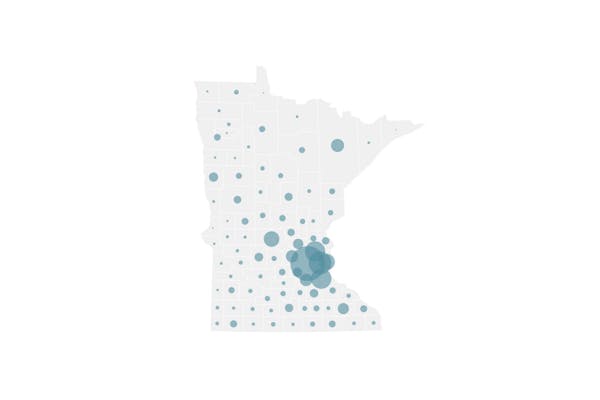Minnesota is showing some early signs of success in its effort to address COVID-19 vaccine inequities by targeting the most vulnerable communities for shots.
The number of people receiving a first COVID-19 vaccine dose has increased 6.3% since state health officials announced in early May that they would allocate 40% of first doses to geographic areas that are home to racial minorities, the unemployed, people with disabilities, non-English speakers and others facing barriers to health care.
That's slightly better than in areas that are the least vulnerable, where first doses increased 5.8%, according to a Star Tribune analysis of state data.
"We are just starting to see the impacts ... and that is encouraging," said Dr. Nathan Chomilo, vaccine equity director for the Minnesota Department of Health.
"It is going to take much more than just getting the shots intentionally allocated. It is going to take that ongoing engagement and communication and finding ways to decrease barriers," Chomilo said.
Much of that work is focused on bringing the vaccines into the communities that have been hit the hardest by COVID-19 infection, hospitalization and death.
One of six Metro Transit buses that have been repurposed into mobile vaccine clinics was administering second doses of the Moderna vaccine Thursday in the parking lot of HmongTown Marketplace, a St. Paul shopping center that has more than 200 vendors.
"We've lost a lot of friends and it is so sad," said owner Toua Xiong. "Just in November and December alone I have lost a lot of friends who I admire."
Xiong said he will continue to host vaccine clinics as long as there is need.
"As soon as vaccinations happen at HmongTown Market everyone knows where it is so it is really easy to one day come here and make it a one-stop trip," he said.
The strategy to close the gap in racial and ethnic disparities in vaccination rates relies on local community settings rather than larger mass vaccine sites in convention centers or health care clinics.
"We want to remove as many barriers as possible to ensure that people are getting vaccinated," said Lt. Gov. Peggy Flanagan. "So bringing doses directly to the community is one of the ways that we do that in a place where you feel welcome."
But it is an approach that involves coordination between health care, public health, community advocates and venues, such as churches.
Flanagan noted that 62 community vaccination events were scheduled this week, along with another 135 in the coming weeks.
As was the case in St. Paul on Thursday, interpreters are on hand in neighborhoods that have a higher proportion of non-English speakers to help answer questions about the vaccine.
Non-English speakers are particularly vulnerable to COVID-19 complications, according to a recent study.
"Even after controlling for socioeconomic status, non-English speakers across and within minority people were more at risk for severe COVID-19 disease," said Dr. Nick Ingraham, a third-year medical fellow at the University of Minnesota Medical School and lead author of the study. "This is a very vulnerable community that we need to figure out better ways to care for."
Using about 5,600 de-identified patient records from the M Health Fairview system, the study also found that racial and ethnic minorities were more likely to develop severe outcomes from COVID-19 infection — a conclusion that has been noted in state Health Department data about hospitalizations and deaths.
But Ingraham also discovered that minorities from higher income areas did not fare much better.
"Seeing an increased risk of severe COVID-19 disease in people of color and non-English-speaking, independent of other known risk factors, these populations should be considered high priority for the continued vaccination rollout," Ingraham said.
Using an index developed by the U.S. Census Bureau, researchers have computed a "social vulnerability index" score for about 860 Minnesota ZIP codes, which are meant to reflect communities that historically have had less access to health care.
State officials estimate that 58.5% of those who live in the 209 most vulnerable ZIP codes have gotten at least one dose of the vaccine, while 67.3% of those residing in the 215 most low-risk ZIP codes have received at least one shot.
This mirrors the racial and ethnicity vaccination rates, which show that while 57% of the white population age 16 and older have gotten at least one shot, rates for Indigenous, Black people and Hispanics range from 37 to 42%.
The Asian community has the highest rate at 61%. However, it is unclear what the rates are for specific groups within the community such as Hmong and Karen. Some community groups have called on state officials to develop more detailed data so that vaccination and prevention efforts can be better targeted.
Say Vang, the COVID-19 program manager for the Hmong American Partnership, said acceptance of the vaccine has been growing within the Hmong community.
"There was hesitancy at the beginning," Vang said. "But in the Hmong culture I see that because the leaders are getting vaccines and the Hmong elders are getting vaccinated, it is breaking that hesitancy and now more people are getting the vaccine."
Chomilo said the state will reevaluate its approach to closing the vaccine equity gaps at the end of the month.
Statewide, 2.8 million Minnesotans age 16 and older have received at least one shot, with 2.4 million receiving the required number of doses.
Meanwhile, new COVID-19 infections and hospitalizations continue to trend downward, with 874 cases reported by state officials Thursday.
There were 412 COIVD-19 patients in Minnesota hospitals, down from 453 a week ago.
Another eight deaths were announced Thursday, including one long-term care resident.
Since the pandemic began in Minnesota, 597,052 have tested positive for the coronavirus and 7,333 have died from COVID-19 complications.

Minnesota State Patrol celebrates diverse new class of troopers

Fired Mpls. teacher accuses management of 'cancerous rot'

Jill Biden rallies women, teachers for the Biden-Harris ticket in Bloomington speeches
Neighbors, city officials at odds over Rochester lake dam

